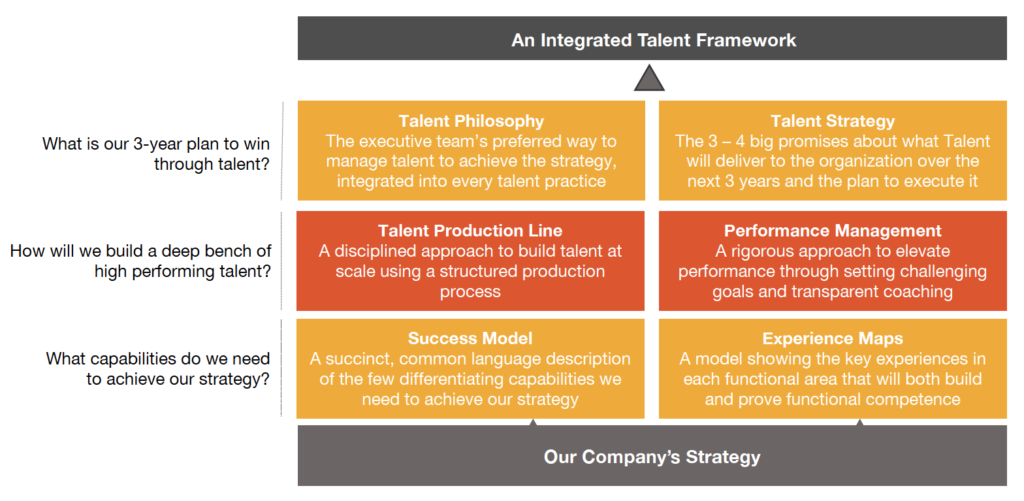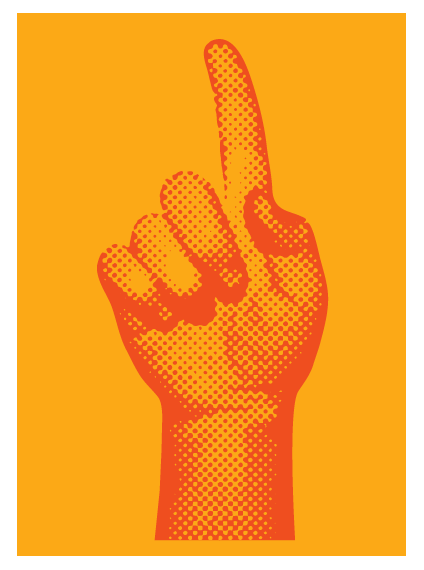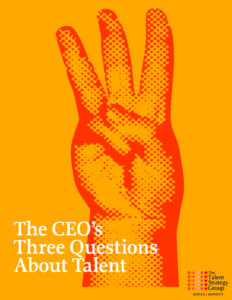Please enter your email in order to download this publication.
By Marc Effron, President, Talent Strategy Group
The CEO was visibly frustrated just a few minutes into the CHRO’s presentation.
“I’m sorry, but I’m confused” she said. “This feels like the 10th different process that HR has asked our teams to absorb just this year. Why this one now?”
The CHRO responded calmly, “I understand that we’re all very busy and I appreciate everyone’s support. We agreed as an executive team that talent is a top priority this year. So, my team is moving forward with speed.”
“You know that I’m completely on-board with doing more for our talent,” the CEO replied, “but, how does this initiative support our strategy? And, how does this fit with what you presented last month?”
“Today’s discussion is about making our leaders better at coaching,” the CHRO replied. “Our last conversation was about increasing everyone’s engagement. These are each important for our success.”
“I’m sure that they’re each important but it’s not obvious how all of these initiatives fit together. When it comes to talent I want to know what capabilities we need to win, how do we get a deep bench of high performing talent and what’s HR’s plan to make this happen? Does this piece of work answer any of those questions?”
Similar conversations occur far too frequently in boardrooms across the corporate world. They start with a well-intentioned CHRO or talent leader who’s committed to advancing an aggressive talent agenda. That leader creates new talent initiatives for the company and advances them in rapid fire succession.
Each initiative seems valuable but there’s no cohesive story or integrating framework to help the organization (and HR) understand why this activity, why now and how the pieces fit together.
Overwhelmed executives feel like they’re being served every item on a restaurant menu at the same time with no chance to digest any individual dish.
CEOs become frustrated with what appear to be random activities. Support fades, talent agendas fail and CHROs are replaced.
Answering the CEO’s Three Questions: The Integrated Talent Framework
The CEO’s questions are incisive, outcome-focused and the same ones that any smart investor would ask. The challenge is that many HR groups either can’t decisively answer those questions or their answers comprise a lengthy list of disconnected activities.
We find that an Integrated Talent Framework (ITF) is a simple and powerful way to easily explain to your company’s leaders why you’re doing what you’re doing with talent and how the pieces fit together.
The ITF should ideally be assembled before the CEO asks her questions and used to give context and logic when discussing what you’re doing for talent and why.
You’ll see in the model below our view of what talent practices would answer the CEOs questions. We describe below exactly how we would voice and implement those answers.

1. What capabilities do we need to win?
HR’s answer:
“We’ll identify both the differentiating leadership and functional capabilities that will best advance our strategy.
The leadership capabilities will be few, crisp and differentially drive performance. We will work with you and the executive team to determine these and we’ll build and reinforce them in every people process.
They’ll be expressed in simple language that sounds like our company using what we call a Success Model.
The functional capabilities will be determined by your functional leaders and their teams. We’ll help them identify the experiences that matter most to build functional excellence. We’ll make it easy for everyone to understand how to grow these.
You’ll see the result as Experience Maps in each function. These will be the key guide used to develop individuals and groups.
This is how we’ll determine the capabilities we need to win.
Your Integrated Talent Framework should start by answering this question. If you don’t know which few capabilities matter most, every talent-building activity is just building random capabilities that may or may not support your strategy.
This question has two-parts as we describe above – one focused on leadership and one focused on technical or functional depth. Here’s deeper content on each element.
The Success Model. When we ask clients, “What are the differentiating capabilities of the leaders who will best drive your strategy?”, we usually get one of two responses.
The first response is a blank stare because, while the company has frequently spoken about the need for great leaders, they haven’t defined what they mean by that term.
The second response is that we’re shown a competency model which lists the 10, 15, 20 or more competencies they’ve identified to define a good leader. Neither response is helpful.
The most productive answer to the CEO’s question on capabilities is structured as what we call a Success Model. A Success Model defines the few, differentiating capabilities that will allow your company to win over the next three to four years. The few Success Model statements are defined in the language of your company, are aspirational and include only the differentiating capabilities.
The traditional leadership competency model confuses “good citizen” behaviors with those that truly differentiate performance. Both are important, but the former is expected and the latter takes meaningful effort to build.
The Success Model provides a clear “production” target for talent management. Your executive team has declared these to be the most desirable capabilities and your talent team can now align the company’s selection, development, coaching, succession and compensation practices to reinforce those capabilities.
Experience Maps. When we ask about the most critical functional capabilities, we again see a carefully produced set of competency models. There is a model for each function and they are multi-page, multi-layered descriptions that completely capture every element that goes into performing a job.
We find these models to be correct but not helpful. In other words, there is more than enough verbiage in them but that verbiage is not easy to understand or apply to the process of building better talent faster.
We believe that a far more compelling answer to the CEO’s question is to focus on what the science says is the most powerful lever of development – experiences.

An Experience Map answers the capability question by explaining the experiences that matter most to build functional competence in a particular area. It’s created by your company’s experts in that function, and presented in a way that shows the experiences that matter most, described in succinct but accurate phrasing.
Your Experience Maps replace your functional competency models in everything from hiring screens to development planning. You can keep the competency models in your “back pocket” in case a leader is highly curious about the building blocks of experiences.
The conversation about capabilities with the CEO and executive team should start with, “This conversation is about building the few capabilities we need to win. Here’s how we plan to do that.”
2. How will we get a deep bench of high-performing talent?
HR’s answer:
There are two different deliverables in that question – high-performing talent and as much of it as the organization requires. Here is how we’ll deliver each.
We’ll deliver high-performing talent by sharply increasing our leaders’ ability to set great goals and transparently coach their team members. Our organization, like many others, still does not do this well and that undercuts the largest levers of individual performance.
You’re used to hearing goals and coaching described under the heading of performance management and you might consider it to be an administrative process. What you’ll see from us going forward is that this is not an administrative exercise. It’s a strategy-execution exercise and we will help you to manage it that way.
We’ll also create consequential accountability for both high-quality goal-setting and transparent coaching. Managers who execute these activities well will see more opportunities to grow and to earn.
To the second part of your question, we’ll help the organization produce a deep bench of talent using a rigorous talent production process. We believe that great talent can only be produced at scale by using the same discipline that we use to produce our products and services.
This talent production line approach allows us to build more, better quality talent faster. It also allows us to easily explain to you and others what we’re trying to build, by what process and when you can expect that talent to be ready.
While we don’t control every element of talent production, we will take full accountability to make the talent production line operate with speed and efficiency.”
How will you ensure consistently high performance?
You should feel confident answering the CEO’s question since our field has incredibly strong science that informs the best way to manage performance.
Few, big goals. We know that great performance has to start with every team member having a few, highly challenging and well aligned goals. What’s your plan to ensure this happens?
We would suggest that the two largest levers are to create a process that reinforces setting only a few large, challenging goals, and run a disciplined audit and review process to ensure that this happens. Most organizations don’t do these activities, and so most aren’t great at driving high-performance across the enterprise.
2+2 Coaching. The other powerful lever is frequent and transparent conversations with employees about performance and behaviors. Many organizations give their leaders complex coaching models and unrealistic expectations for the time they will spend in this area.
Your answer to the CEO’s question should include how you’ll ensure transparent and frequent coaching conversations and measure their effectiveness.
We recommend the 2+2 Coaching approach to ensure that every leader has regular conversations about what matters most with each of their team members. Its radically simple design removes any excuse that a manager might claim for not having frequent, transparent conversations. It’s also easy to measure the quality of those conversations.

There’s one essential step that an HR organization needs to take to make all of this work and it’s taken by very few HR organizations. The HR team has to become expert in both goal setting and coaching, and actively consult with leaders on those processes.
Too many HR shops adopt what a recent client called the “train and pray” approach. That approach proves to be just as effective as you might imagine.
How will you create a deep bench of talent? True talent depth is difficult to build and can only be done with well-coordinated, company-wide action. You need to prove to the CEO that you have an “industrial -strength” approach to producing talent.
Talent Production Line. Your answer to this part of the CEO’s question should reflect that you’ll build talent quality and depth at scale using a structured and disciplined Talent Production Line. The Talent Production Line concept resonates with managers because they understand that you can build talent just like you would build anything else.
The Talent Production Line starts with your defining the talent that you’re trying to build. This may have happened in your Success Model process or you may be identifying a more specific group of leaders you want to build, i.e. country general managers.
After you are clear on the specifications, you need a robust process to identify the talent that has the best potential to grow into your specifications. This is typically your talent review process, so you need to ask yourself if that process accurately predicts which leaders can quickly grow their capabilities.
The best metric for successfully predicting potential is to look back five years and evaluate actual leader progress against the talent calls made at that time.
The most challenging part of the talent production line is mapping the actual production process – identifying the experiences, exposure and education that leaders need to accelerate their development. We like to start that process with an Experience Map to ensure that the developmental ”70” in “70/20/10” gets the attention that it deserves.
3. What’s the three-year plan to win through talent?
HR’s answer:
“Our HR team has discussed and agreed on three big talent deliverables to the organization over the next three years.
These deliverables are the result of our looking in depth at our business strategy and identifying these three priorities from amongst the other valuable ways that we can support the business. We validated these three with senior business leaders.
These strategic planks – “A”, “B”, and “C” – are the largest levers that we have to support the business strategy through talent. We will hold ourselves accountable to the executive team for achieving these. We will prioritize achieving these over other needs and requests from the business.
We have many other things that we do to support talent here at XYZ Company, but this strategy represents our three-year plan to win through talent.
We will also win by deploying a consistent way of managing talent across the organization. As an executive team, you will agree on the best way to manage talent to achieve our strategy. We will then realign every people process to reinforce that way of managing.
We will be transparent with our leaders that they need to manage this way and with our employees that they will be managed this way.
This “talent philosophy” will ensure that everyone manages their teams in what you believe is the optimal way to achieve our strategic goals.”
These two foundational elements –a talent strategy and a talent philosophy– don’t exist in many organizations and are highly generic when they do. These represent the “what” and the “how” of talent management.
Talent Strategy. Once you’re clear about what talent to build, you can create your three-year plan to win through talent. An executive-impressing talent strategy makes clear promises about the 3 – 4 talent outcomes that HR will produce for the organization
“Outcomes” is the key word in that sentence. We see far too many talent strategies organized under headings like “Engagement” or “Development” or with vague deliverable like “Foster the growth of all leaders.”
An outcome is a specific deliverable such as “Build ‘Ready Now’ Depth for Every Global GM Role by 20xx.” That statement says exactly what you will deliver, by when and how the outcome will be measured.
We find that four or fewer items in a talent strategy ensures a focus on what matters most to the organization. This doesn’t suggest that there aren’t many other important outcomes to achieve, but that these four are the most critical for the talent management organization to deliver in the next three years.
We also believe that the largest, most impactful goals aren’t completely controllable by talent or HR. The example above – Build ‘Ready Now’ Depth for Every Global GM Role by 20xx – requires that talent teams work with many different functions and leaders to build a sustained talent production process.
High performing talent and HR teams are happy to sign up for these larger deliverables because they understand the value of business impact vs. HR activity.

HR Effectiveness. Form follows function, so your organization structure and your talent management operating model should flow directly from your strategy. What groups should be in talent management and why? How will the talent team work together? How will you work with your HR partners to best achieve your strategy.
The answer to that last question often holds the key to delivering the talent agenda. With most talent management work executed through HRBP’s, the relationship between the talent management COE and your HR business partners must be strong and effective.
We find that there is never a perfect relationship between these two groups but there’s also little effort in most companies to improve that relationship and agree to an operating model.
Talent Philosophy. Your talent strategy describes what you’ll do for talent. A Talent Philosophy describes how talent will be managed.
A Talent Philosophy is your executive team’s preference for how to manage performance, behaviors, accountability, transparency, and differentiation to best achieve the business strategy. It provides operational guidance to your managers about how to manage talent and to HR for how to design talent practices.
The Talent Philosophy is your reference point for how to operationalize every talent practice. What should the balance of performance and behaviors be in performance management? Check your talent philosophy. Should we be transparent with talent about their potential? Check your talent philosophy. What happens to leaders who don’t develop successors? You get the point.
A clear and well-communicated Talent Philosophy also means that managers can easily explain the purpose of talent processes and employees know that talent decisions are made using a consistently and equitable approach.

Answering the CEO’s Talent Questions
There’s a limitless appetite for talent management support in most organizations today. As HR leaders, we should be thrilled with this strong demand and be able to provide logic to what support we provide and how.
Too often, we don’t effectively explain how what we’re doing answers the questions that the CEO cares about most. The Integrated Talent Framework can organize how we structure and speak about our work, help prioritize our actions and allow us to clearly answer the CEO’s three questions about talent.

More About The Author:
- Marc Effron, President, Talent Strategy Group
- Marc founded and leads The Talent Strategy Group and consults globally to the world’s largest and most successful corporations. He co-founded the Talent Management Institute and created and publishes TalentQ magazine. He co-authored the Harvard Business Review Publishing best-seller One Page Talent Management and 8 Steps to High Performance.

